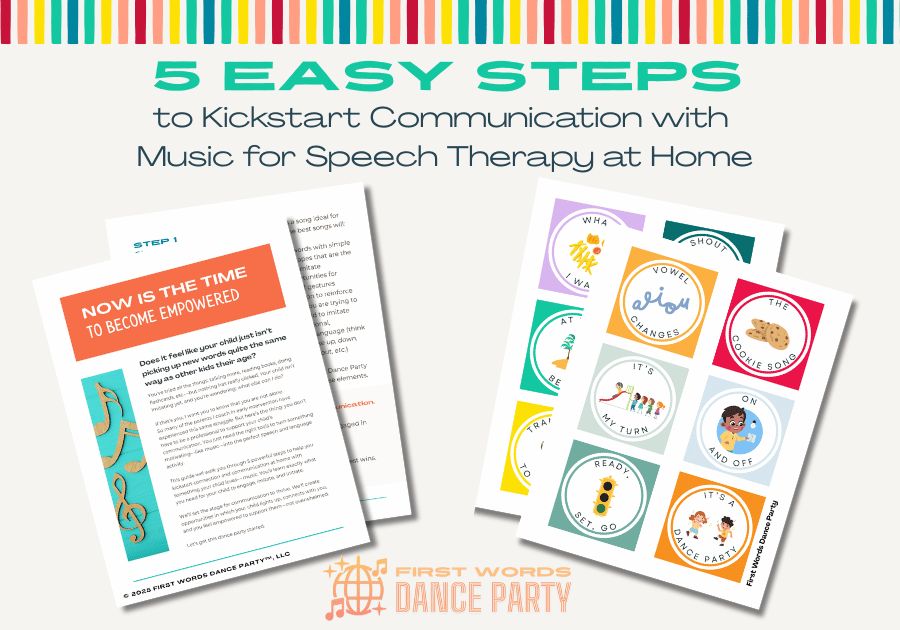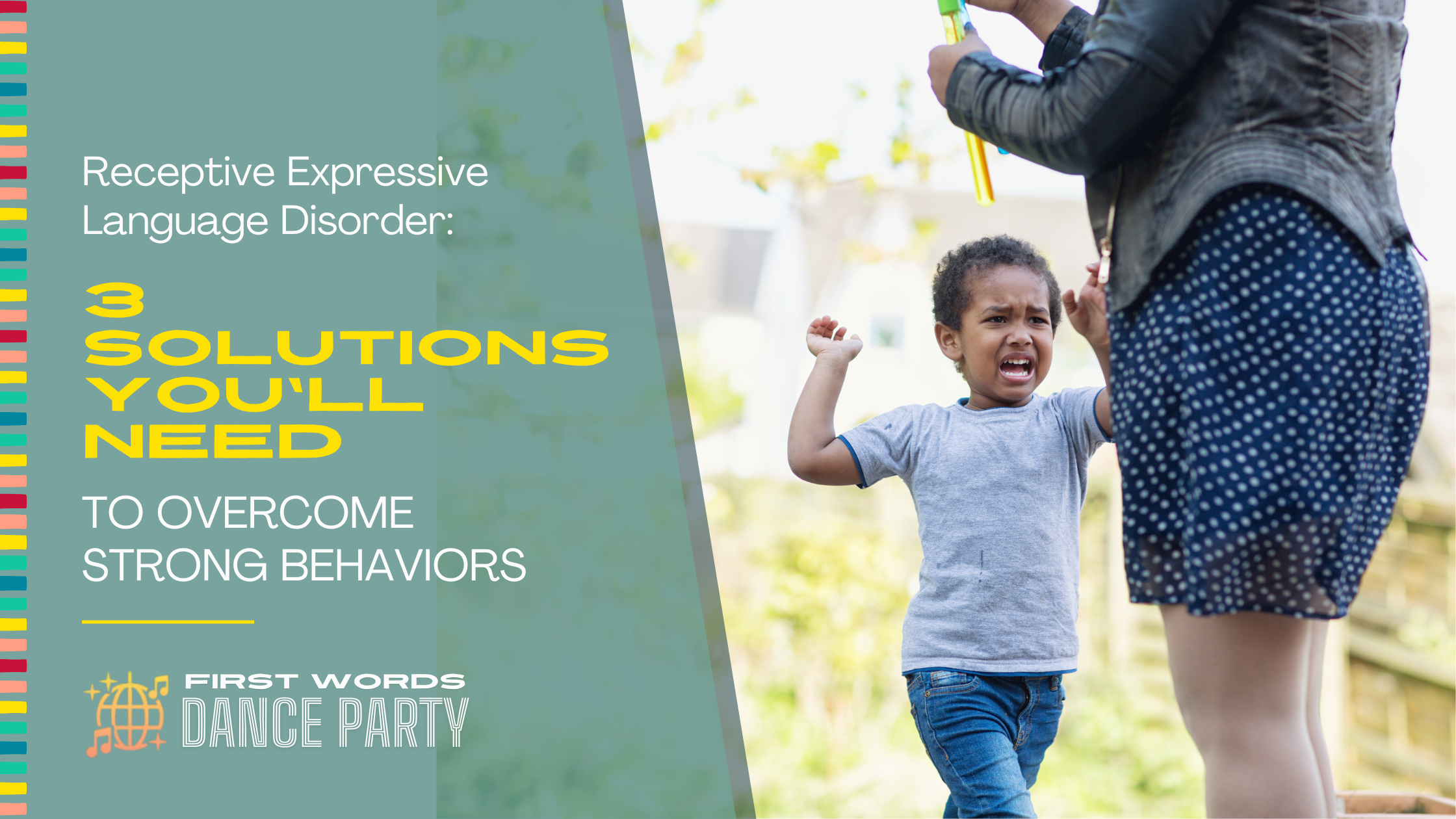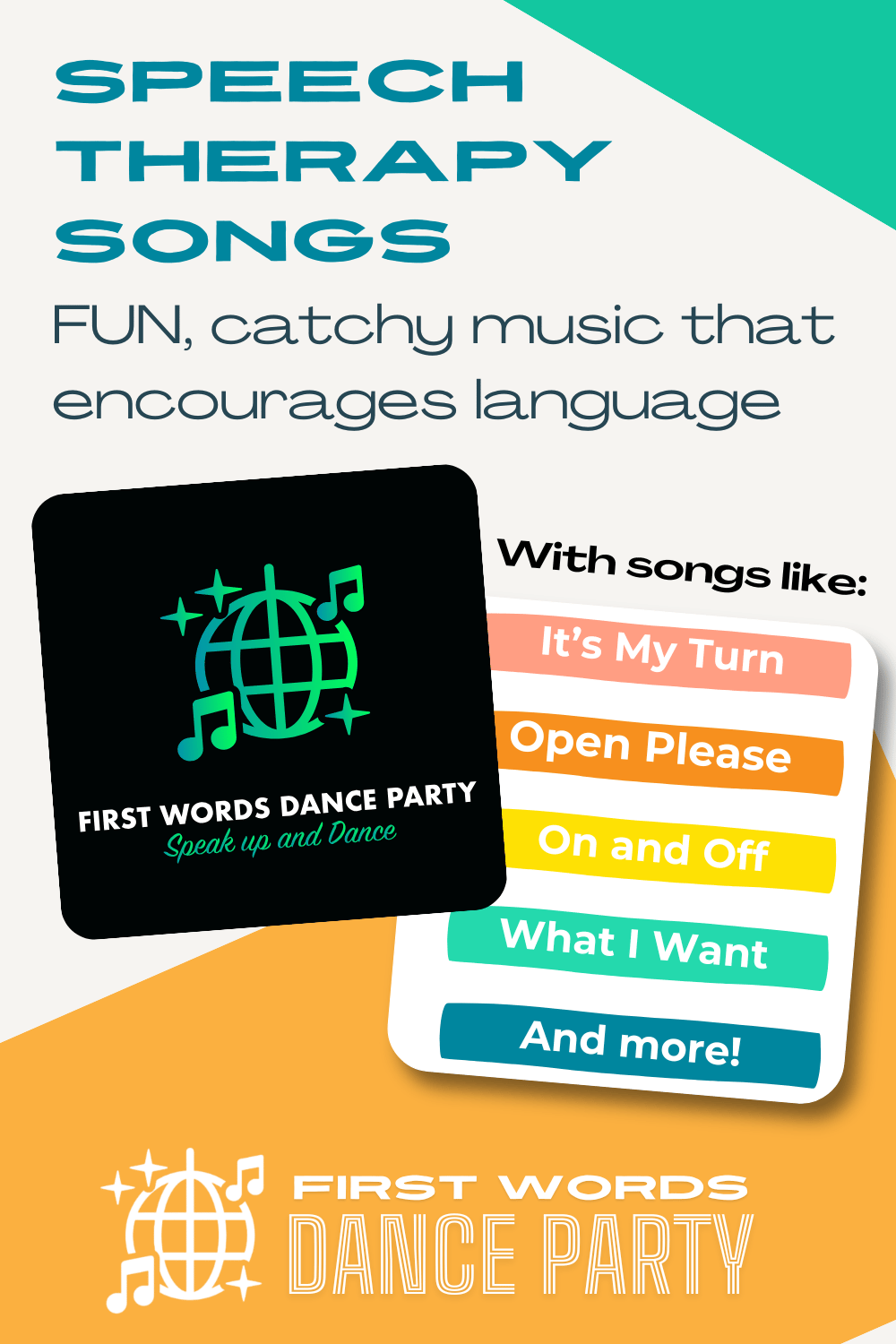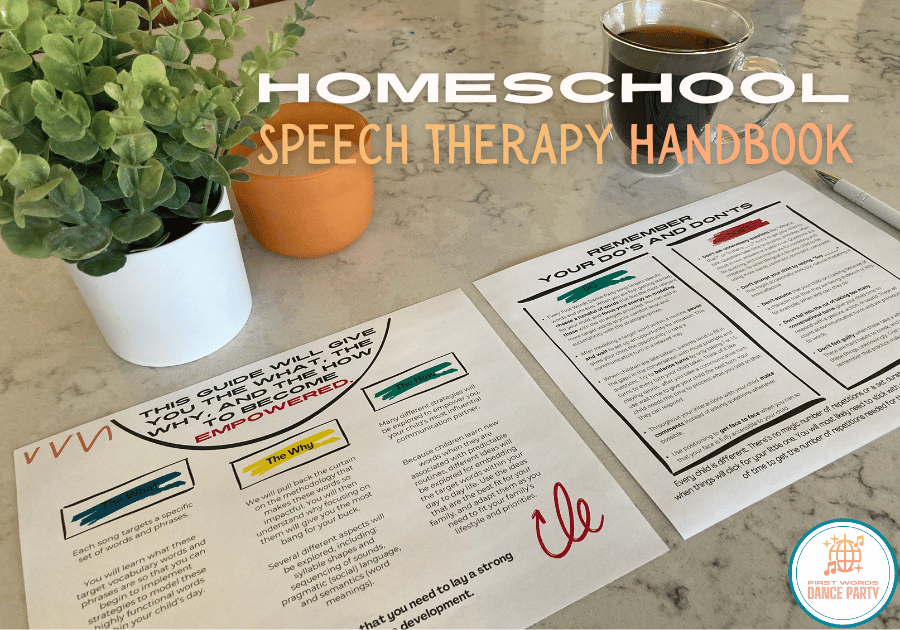Expressive and Receptive Language Disorder: How to Use Music for Joy and Success
- 0 comments
If your child was just diagnosed with an expressive and receptive language disorder, and you’re feeling overwhelmed— you’re not alone.
You waited for their first words to come, and when they didn’t, then you waited weeks or even months for the first speech therapy appointment. You filled out all the forms, answered all the questions, and sat close by as the speech-language pathologist evaluated your child.
And now you’re holding the evaluation report with those words printed across the bottom: receptive expressive language disorder.
Maybe your heart sank from the weight of that long diagnosis. Maybe you’re wondering:
How serious is receptive expressive language disorder? Will my child ever talk?
If this sounds like you, know that you’re not alone. Yes, this diagnosis can feel scary—but a diagnosis doesn’t define your child’s future; it gives us a way to better understand and connect with your child in this present moment.
A way to understand what’s happening right here and right now, so we can begin to build bridges to communication.
In this post, I’ll walk you through what expressive and receptive language disorders are and what you can do to support your child starting today- like, this afternoon.
I’ll share the approach that’s made a world of difference for so many of the families I’ve supported in early intervention over the years.
If your child isn’t using many words yet, you may be unsure of what to do and what not to do- and you’re not alone. Many parents I coach in early intervention feel stuck, frustrated, or overwhelmed when their child won’t imitate their words.
That’s why I started creating music for speech therapy that weaves in the strategies we use everyday in early intervention.
You can download a free guide to discover 5 easy, parent-friendly steps to use songs for speech therapy to spark connection and communication with your child. As a bonus, you’ll receive song boards with cards for every First Words Dance Party™ song, so your child can make choices and initiate.
Alright, let's get started.
What Is Expressive and Receptive Language Disorder?
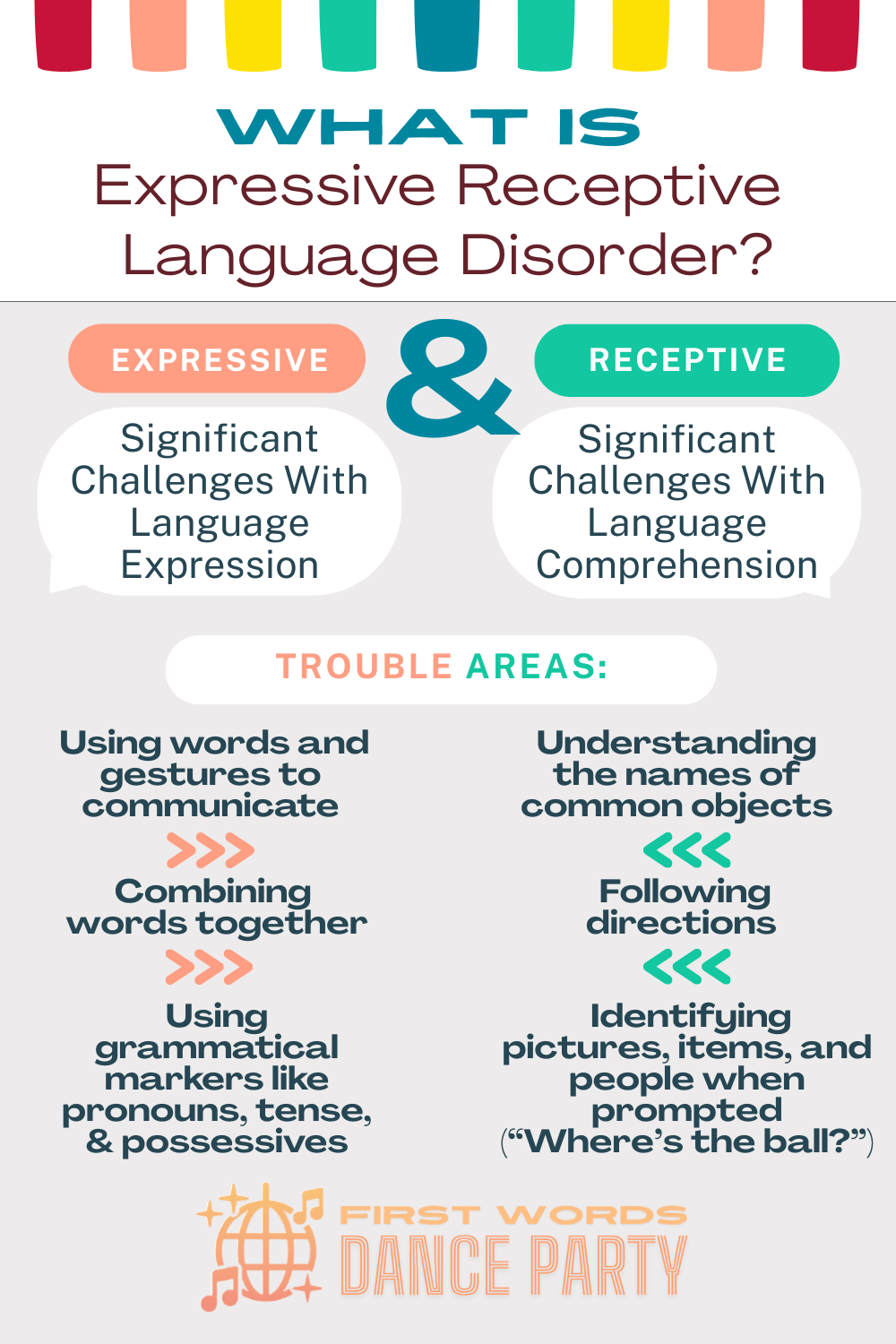
An expressive and receptive language disorder means that a child has significant difficulty with both understanding (receptive language) and using language to communicate (expressive language). It’s usually diagnosed in the toddler and preschool years when parents notice that their child is having difficulty following typical speech and language milestones.
You may hear this diagnosis go by many variations: receptive expressive language disorder, mixed receptive expressive language disorder, mixed expressive receptive language disorder, etc. These are all different names for the same thing.
While the word order of the different terms can vary depending on what you’re reading or who you’re talking to, the diagnosis is the same: both understanding and expressing language are challenging for that child. For the purposes of this article, I will include all of the most common terms that you are likely to hear.
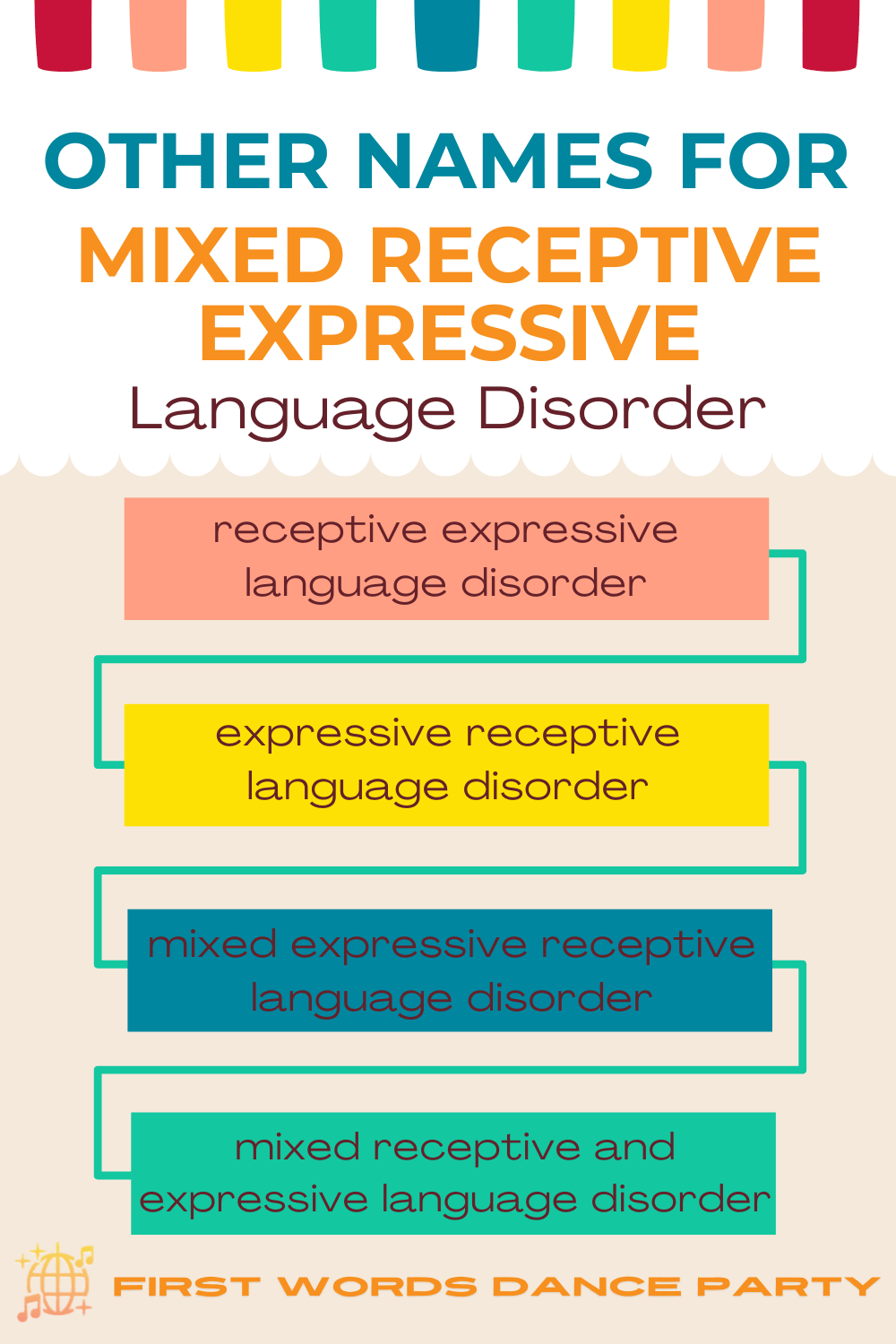
Speech and language milestones impacted by mixed receptive expressive language disorder
Between 18-24 months, most toddlers are rapidly building vocabulary, combining words, and starting to follow simple directions. Most toddlers will hit the speech and language milestones of using 10-50 words by the time they are 18 months old and using at least 50 words and regularly putting word combinations together by their second birthday.
A toddler’s receptive language is also growing during this time as they learn the meanings of names for objects, action words, and descriptive words and become increasingly better at following a wide variety of one and even two-step directions.
But for children with receptive expressive language disorder, language doesn’t come so easily.
It’s natural to feel uneasy and to wonder what this means for your child.
A diagnosis of receptive expressive language disorder gives us a helpful lens
But here’s the good news: a diagnosis like this gives us a helpful framework. It doesn’t predict your child’s future—it simply describes their current communication profile so that support can be tailored to meet them where they are.
📘 If you're looking for more clinical information, you can explore this overview from ASHA (The American Speech-Language-Hearing Association), a trusted organization for speech and language development research.
What receptive and expressive language disorder may look like at home
Every child is different, but when a toddler or preschooler has a mixed receptive and expressive language disorder, there are patterns that show up in everyday life—things that can feel frustrating, confusing, and even isolating for parents.
You might notice that your child:
Doesn’t understand the names of common objects, action words, or descriptive words
Can’t follow simple directions like “Put your cup in the sink”
Doesn’t use a variety of words and phrases to communicate with adults or other children
Has frequent meltdowns
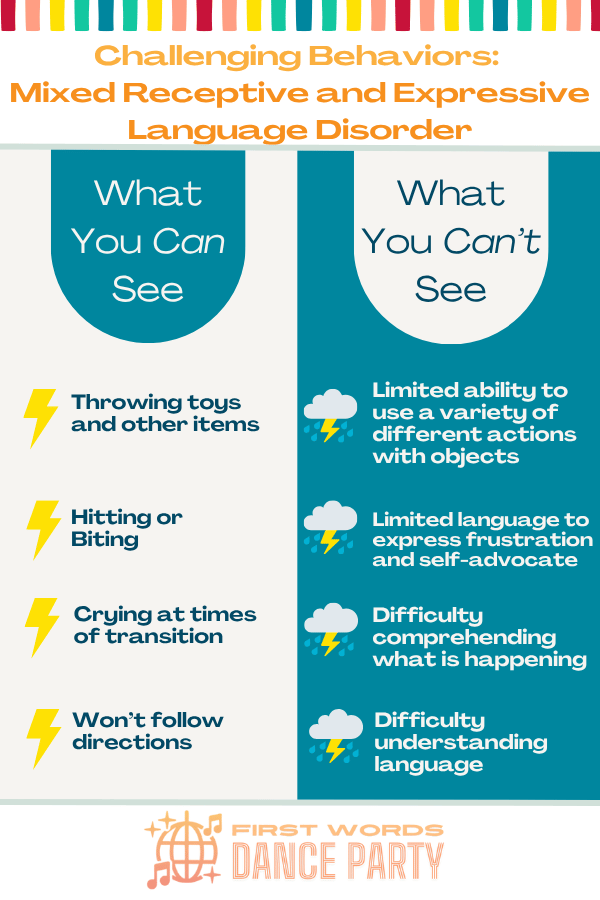
Sometimes, well-meaning people might assume your child “doesn’t want to talk” or “is a selective listener”. But what’s really happening is deeper than that. Your child is struggling to make sense of language, while also not yet having a reliable way to express what they want or need.
And when those needs aren’t understood, big feelings (ahem, meltdowns) come out.
Challenging behaviors in mixed expressive and receptive language disorder
I wrote a separate article that explores how these language challenges can show up as challenging behaviors. If you feel like your day to day routines with your child are full of meltdowns and communication breakdowns, then I encourage you to read this post with solutions to overcome challenging behaviors in receptive expressive language disorder.
But right now, what I want you to hear is this:
You didn’t do anything wrong.
Your child’s language struggles are not a reflection of your parenting.
Your child is trying to connect—and we can help them get there.
The Most Important Thing to Know
If you remember just one thing from this post, let it be this:
A diagnosis of a mixed expressive and receptive language disorder doesn’t shut the door on your child’s ability to talk, but it does show us which doors to open next.

An expressive and receptive language disorder simply means your child needs more support—and more ways in—to understand and use language.
This is where multi-modal communication comes in.
How to Support Your Child at Home
When you’re navigating an expressive and receptive language disorder, it can feel like your wheels are spinning. You may be wondering how to do speech activities at home when your child doesn’t easily pay attention or imitate you.
But you don’t need flashcards or special therapy tools that promise to help your child talk.
You can create connection and communication with your child right now by modeling core language in natural, engaging ways with multi-modal communication for speech therapy at home.
And one of the easiest, most enjoyable, and most powerful ways to do this at home is through music- something your child loves.
What is multi-modal communication?
Multi-modal communication is the use of more than one method to support understanding and expression. It might include:
Spoken Words
Gestures
Facial expressions
Sign language
Visuals
AAC tools (like pictures, devices, or communication boards)
Written words
Intonation, melody, and rhythm (more on this later!)

Each of these methods creates a bridge to communication. When a child is struggling to make sense of spoken language alone, these tools offer clarity, connection, and validation—for both the child and the parent.
The effect of multimodal communication isn’t that it replaces speech for kids with receptive and expressive language disorder. Instead, it builds the foundation for it.
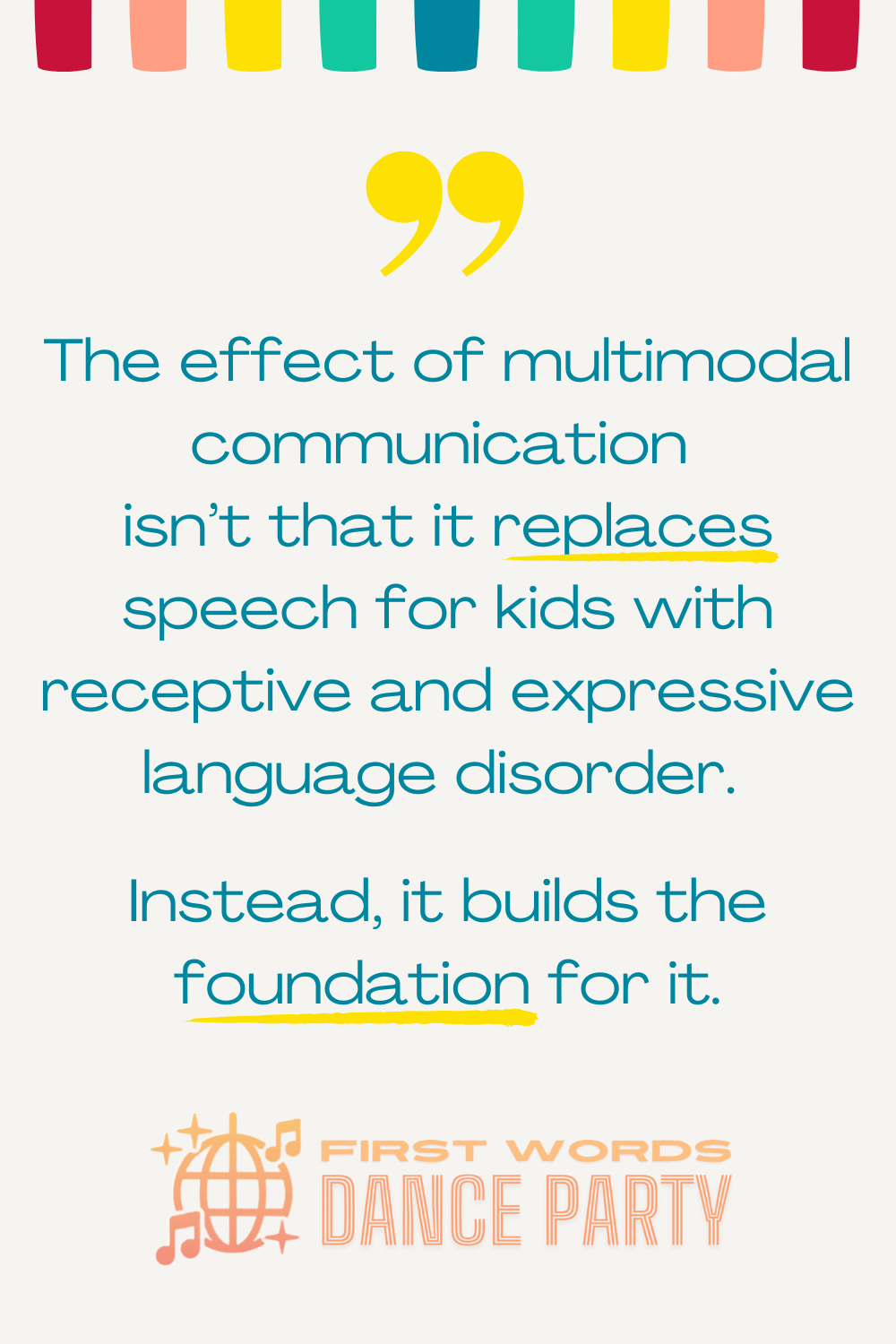
When we offer more ways to communicate, we reduce frustration, increase engagement, and begin to open the door for language to develop in a way that works for your child’s learning style.
Does your child love music?
Do you find that your child tends to pay attention to music more easily than conversation? Does your child light up and engage with you more during their favorite songs than during most other activities?
In my fifteen years of coaching parents in early intervention, I’ve never, not once, met a child who didn’t love music. Music is a powerful force.
Here are reasons to consider music as a component of multimodal communication for children with expressive and receptive language disorder:

It’s a carrier of meaning.
The melody, rhythm, and repetition in a song help children process, remember, and predict what’s coming next—just like they would with a familiar phrase or visual.It’s especially effective for gestalt language processors.
For children who learn in chunks, rather than at the individual word level, musical phrases like “head, shoulders, knees and toes” become whole, meaningful phrases that carry more meaning than when the individual words within the lyrics are used outside of the song.It prompts action, interaction, and engagement.
When a parent sings, “Clean up, clean up” while beginning to clean up toys, the child receives a clear message through:
The words (spoken or sung)
The intonation/melody
The context/routine
The action of placing toys in a bucket as the words are sung
Music can be multi-modal communication in action when it is used intentionally. Music is emotionally rich.
And for kids with speech delays, the emotionality, melody, and repetition that music provides is like magic for processing language.
Combining music and multi-modal communication
In a multimodal communication approach, music offers rich, emotionally meaningful delivery that supports core vocabulary and language development. When paired with gestures or AAC, familiar phrases from songs can help children anticipate and use language.
Let’s take a common children’s song, Wheels on the Bus, and break down the different ways you can use multi-modal communication to support both receptive and expressive language:
👐 Gestures – Model the different actions, like how the lights go blink, blink, blink, and the wheels going round and round
✋ Sign language – Sign “open” during the verse (the doors on the bus go open and shut)
🧠 Visual support – Show a picture or symbol of a bus. Point to the wheels, lights, door, etc. when they are mentioned in the song
💬 Verbal modeling – As you sing, exaggerate the words you’d like to target most for extra emphasis.
🗣️ Pause for participation – Pause intentionally to invite your child to participate: “The wipers on the bus go...”
🎤 AAC modeling – Tap the core words you’d like to target, like up and down, on a low-tech, printed core board as you sing the words
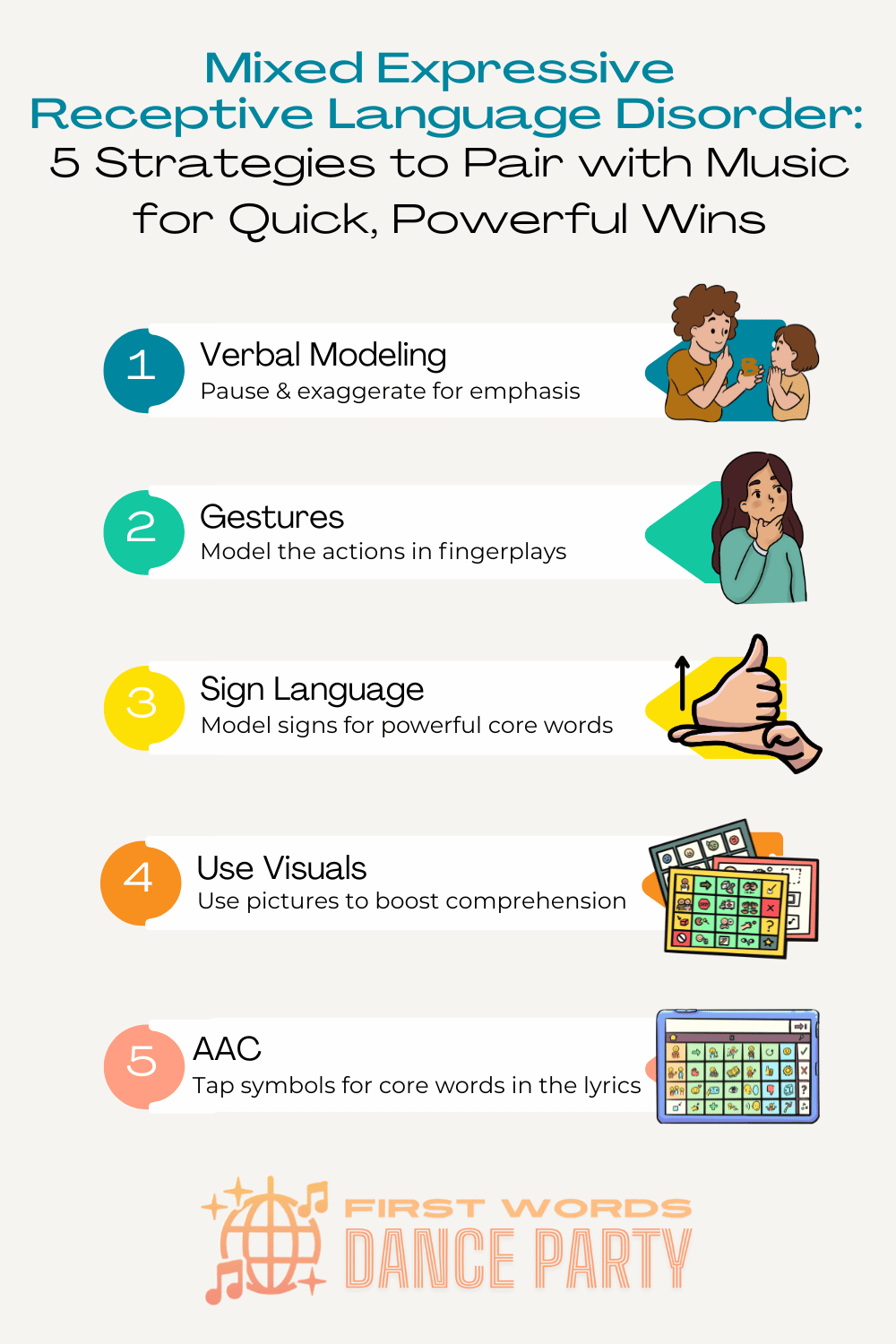
When you think about it, it’s amazing all of the different ways that we can tap into the power of music to support language development even further. And because children naturally love music, it’s a no-brainer for children with receptive expressive language disorder.
This is what inspired me to create First Words Dance Party —music for speech therapy designed for families like yours, and built on these same strategies.
Original speech therapy songs for mixed expressive receptive language disorder that work
First Words Dance Party is a collection of original songs for speech therapy written just for speech and language development. Each track is catchy, fun, and built around carefully chosen core words—functional words like go, open, help, and more that children need across daily routines.
These aren’t just cute kid songs. They’re grounded in research and designed with intention—so that children with expressive and receptive language delays can connect and communicate through music.
Here are a few examples:
“The Cookie Song”: A kid favorite that models the words yes and no with lots of repetition and rhythm, along with the phrases "I wanna eat", "I'm hungry", "Let's eat, please". This one is perfect for children with speech delays who don’t yet say the words yes and no
“Ready, Set, Go”: A super fun little number that models the “magic” phrase "Ready, Set, Go!", along with other important words like like more, uh oh, oh no, push, and pull
“What I Want”: This one targets words to self-advocate, like "I want to go outside", “shoes on”, "open the door", "I want to eat chicken nuggets", and "I want water, please".
“On and Off”: This core words song models on and off, as well as the core vocab words come, turn, stop, and all done through a storyline about listening to a favorite song. Check out the core word video below to see how you can model AAC along with the songs.
You can stream First Words Dance Party on Spotify, YouTube Music, Apple Music, and anywhere else you get your music.
Fun, easy speech therapy practice at home
If you’ve ever felt the weight of trying to support your child’s speech progress at home—wondering “Where do I even start?” or feeling like the things you have tried just haven’t been successful—you’re absolutely not alone. Trying to navigate speech therapy home activities that feel meaningful and manageable (rather than another exhausting to‑do) can leave you drained, second‑guessing, and wishing for something simpler.
That’s where the Homeschool Speech Therapy Handbook comes in. Designed specifically for parents (not trained therapists) who want real‑life tools, this guide breaks down exactly what to do, why it works, and how to bring speech‑therapy practice into everyday moments—snack time, bath time, play time—without turning your home into a clinic.
Framed within a song-by-song breakdown of the Speak up and Dance album, you’ll discover how to apply the strategies within each song to real life for easy speech therapy practice at home. You’ll move from feeling overwhelmed and unsure to feeling confident and connected—watching your child engage, communicate, and grow in ways that feel easy and natural.
Parenting a child with mixed receptive and expressive language disorder is hard, but you’re not alone
If your child has a receptive and expressive language disorder—or if they’re simply not speaking yet—know this: there is a way forward.
You don’t need to become a speech therapist to connect and communicate with your child. You just need the right tools, the right support, and the right strategies that fit into your real life.
Ready to take the first step toward connection and communication with your kiddo? Download your free 5 Easy Steps to Kickstart Communication with Music for Speech Therapy at Home.
Let’s build those bridges together—joyfully, meaningfully, and one song at a time for our super special kiddos with expressive and receptive language disorder.
FAQ
What is expressive and receptive language disorder?
Expressive and receptive language disorder is a diagnosis used when a child has difficulty both understanding what’s said to them (receptive language) and expressing thoughts, needs, and ideas (expressive language). It’s a common diagnosis in toddlers and preschoolers with speech delays—and with the right support, progress is more than possible.
What’s the difference between receptive vs expressive language?
Receptive language is how children understand others—like following directions and identifying pictures, objects, and people. Expressive language refers to a child’s ability to use words to communicate with others. Children with this diagnosis struggle with both receptive and expressive language.
Can children with mixed expressive and receptive language disorder learn to talk?
Yes. Many children with expressive and receptive language delays do go on to develop spoken language. Every child’s timeline is different, but when we give them multiple ways to communicate—through signs, gestures, visuals, and AAC—we open more doors to language growth.
Do kids with speech delays catch up?
With early support and evidence-based strategies, many children make incredible progress. Some may “catch up” to their peers, while others may continue to need support. Early intervention is very important to get the right strategies in place as soon as possible.
I really, really want my child to talk. Will using sign language keep them from talking?
Not at all. In fact, research shows that using AAC and other forms of multimodal communication can actually encourage spoken language. When a child sees and experiences communication success—whether through a sign, a picture, or a word—they're more likely to build confidence and expand how they express themselves.
My child’s speech therapist mentioned that they might be a gestalt language processor. Is that bad?
Not at all—it's simply a different way of learning language. Gestalt language processors learn in “chunks” or scripts (like lines from songs or shows) rather than individual words. Recognizing this is actually a good thing—it helps us tailor our support. Music, rhythm, and meaningful scripts are powerful tools for these “intonation babies,” and that’s exactly what First Words Dance Party was created to provide.
My toddler and my baby are really close in age, so I haven’t been able to work on my toddler’s speech. Is a speech delay the parent’s fault?
Please don’t carry that weight. I hear this concern from parents quite frequently. Speech delays are common and can happen for many reasons—none of which are a parent’s fault. You’re here, seeking support and showing up for your child, and that is what matters. And the truth is, working on a toddler’s speech doesn’t look like flashcards or drilling—it looks like intentional, connected moments during play, music, and daily routines.
What can I do to help my child now?
Start small. Sing a favorite song and add a new gesture. Model the signs “open” or “more” during a snack. Offer choices with visuals by holding the two snacks as you say, “Do you want cheese or a banana?”.
Many parents find that it works well to pick one routine within their day and sprinkle in 1-2 new strategies to get started in a manageable way. If you haven’t grabbed it yet, download this free AAC Core Word Bundle to get started with song boards and core vocabulary visuals that make communication feel fun, engaging, and natural for kiddos with expressive and receptive language disorder.
